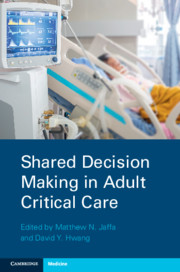Book contents
- Shared Decision Making in Adult Critical Care
- Shared Decision Making in Adult Critical Care
- Copyright page
- Dedication
- Contents
- Contributors
- Preface
- Chapter 1 When Does Shared Decision-Making Apply in Adult Critical Care?
- Chapter 2 How Much Does the Family Want to Be Involved in Decision-Making?
- Chapter 3 Show Me the Data
- Chapter 4 Communication Skills for Critical Care Family Meetings
- Chapter 5 The Do-Not-Resuscitate Order
- Chapter 6 The Do-Not-Intubate Order
- Chapter 7 Prolonged Ventilator Dependence for the Pulmonary Patient
- Chapter 8 Renal Replacement Therapy
- Chapter 9 Shared Decision-Making during Extracorporeal Membrane Oxygenation
- Chapter 10 Hypoxic–Ischemic Brain Injury after Cardiac Arrest
- Chapter 11 Decompressive Craniectomy for Stroke Patients
- Chapter 12 Decompressive Craniectomy for Traumatic Brain Injury Patients
- Chapter 13 Severe Traumatic Spinal Cord Injury
- Chapter 14 Potentially Inappropriate Treatment and Conscientious Objection
- Chapter 15 Shared Decision-Making in Emergent Situations
- Chapter 16 Advance Directives
- Chapter 17 Care of the Unbefriended Patient
- Chapter 18 The Role of Palliative Care in the Intensive Care Unit
- Chapter 19 Measuring and Evaluating Shared Decision-Making in the Intensive Care Unit
- Chapter 20 Brain Death Discussions
- Index
- References
Chapter 12 - Decompressive Craniectomy for Traumatic Brain Injury Patients
Published online by Cambridge University Press: 27 May 2021
- Shared Decision Making in Adult Critical Care
- Shared Decision Making in Adult Critical Care
- Copyright page
- Dedication
- Contents
- Contributors
- Preface
- Chapter 1 When Does Shared Decision-Making Apply in Adult Critical Care?
- Chapter 2 How Much Does the Family Want to Be Involved in Decision-Making?
- Chapter 3 Show Me the Data
- Chapter 4 Communication Skills for Critical Care Family Meetings
- Chapter 5 The Do-Not-Resuscitate Order
- Chapter 6 The Do-Not-Intubate Order
- Chapter 7 Prolonged Ventilator Dependence for the Pulmonary Patient
- Chapter 8 Renal Replacement Therapy
- Chapter 9 Shared Decision-Making during Extracorporeal Membrane Oxygenation
- Chapter 10 Hypoxic–Ischemic Brain Injury after Cardiac Arrest
- Chapter 11 Decompressive Craniectomy for Stroke Patients
- Chapter 12 Decompressive Craniectomy for Traumatic Brain Injury Patients
- Chapter 13 Severe Traumatic Spinal Cord Injury
- Chapter 14 Potentially Inappropriate Treatment and Conscientious Objection
- Chapter 15 Shared Decision-Making in Emergent Situations
- Chapter 16 Advance Directives
- Chapter 17 Care of the Unbefriended Patient
- Chapter 18 The Role of Palliative Care in the Intensive Care Unit
- Chapter 19 Measuring and Evaluating Shared Decision-Making in the Intensive Care Unit
- Chapter 20 Brain Death Discussions
- Index
- References
Summary
Mrs. Smith, a 24-year-old woman without prior past medical history, is admitted to the intensive care unit after a motor vehicle collision with ejection from the vehicle, during which she suffered a severe traumatic brain injury (TBI). The patient was intubated at the scene and remained intubated throughout the hospital course. The patient’s Glasgow Coma Scale after resuscitation was 6T (M4, E1, V1(T)). Serial computed tomography (CT) scans of the head revealed left frontal and temporal contusions in evolution with an increasing amount of pericontusional edema, and mass effect with midline shift of the septum pellucidum and compression of the mesencephalic cisterns (Figure 12.1). The patient was treated according to Brain Trauma Foundation guidelines with intracranial pressure (ICP) monitoring for elevated ICP. Initially the patient responded well to medical management with deep sedation, osmotherapy (mannitol and 23.4% hypertonic saline alternating resulting in a serum sodium level of 165 mmol/dL), and normothermia. Sedation holidays were omitted owing to ICPs spiking to 40 mmHg off sedation. On hospital day 5, the patient’s ICP continued to intermittently spike to 30 mmHg, and she no longer responded to osmotherapy. A repeat head CT scan revealed an interval increase in the midline shift and pericontusional cerebral edema. Given her age and active lifestyle before the injury, the family wanted “everything done.” You call the neurosurgeon and in collaboration with the neurosurgical team you walk into a meeting with the family to discuss secondary decompressive craniectomy (DC) vs. additional medical management with significant potential side effects (induced hypothermia, pentobarbital coma).
- Type
- Chapter
- Information
- Shared Decision Making in Adult Critical Care , pp. 103 - 114Publisher: Cambridge University PressPrint publication year: 2021



